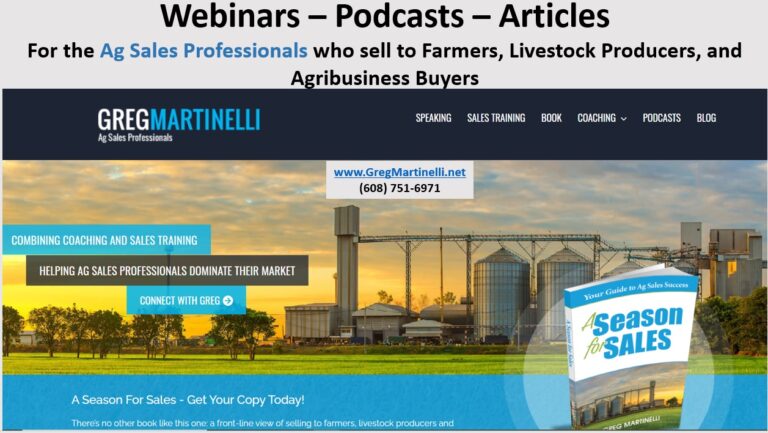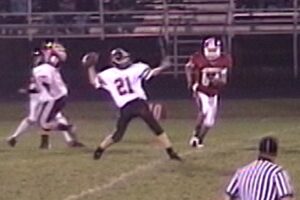I really shouldn’t call them traps because I truly don’t think our customers are setting a trap. They are just busy people and want to get right down to the point. As most of us know, the sales process involves – Connecting-Asking good questions to uncover needs-Presenting a solution to those needs-Closing on the sale and of course good Follow up. We know that and so do many of the farmers and agribusiness professionals out there. Grain and livestock producers can see half a dozen different sales people a day driving onto their farm trying to meet with and sell them something. Not all get meetings, but producers get solicited pretty hard. Same goes with dedicated buyers or managers in Agri-business. Said another way – “They know why you are there”. If you think about it, they get to evaluate 5-7 different sales people a day. Trust me, they get good at knowing how to evaluate. The key is for you to differentiate. We often do that with good questions to understand the customer a little better and then position our solution a little closer to their need than our competitor did. Without these questions and this deeper understanding, we often appear like we are just pushing a product. We get on the farm or in front of our agribusiness prospect and the following two scenarios play out every day on sales calls. They are expected questions, seemingly innocent. Yet, they can take us out of the consultative sales role and into merely presenting a product or even worse – selling on price.
Trap #1: What do you have for me today?
Other potential versions of this one are: “Whatchya got for me today?” or “What are you peddling this morning?”
When a customer throws this question out there early in the sales process, it can be an easy trap to fall into. You want to accommodate the customer. The temptation is to jump right in and start presenting your product. On the surface, the producer is busy, knows why you are there and just wants to get down to business. So, with this question, he is saying, just present your product or service and let’s get on with it. However, you are now off your game. You have questions prepared. You may have even pre-call planned and did some role play. Based on the producer’s answers, you have different features and benefits to promote. This will differentiate you in the customer’s view as not just another sales person. With this one challenging question “What do you have for me today?”, all that preparation and strategy is going down the tubes as your customer appears very busy and doesn’t seem to want to answer a lot of your questions.
What should you do? First and foremost, I am never a fan of any sales person avoiding a question. To me, it signals distrust or not listening. If you need to run through a deeper discussion with questions as mentioned above, then answer the customer’s question with a very short answer. Then go into why you need to ask the customer some questions to help figure out the best solution.
For example: common scenario that I have been involved in:
Ag Retailer: What are you guys promoting this week?
Salesperson: Calf Starter and Chick Days Promotion. I think you’re going to like what we are doing with the program for helping the retailer. You still have a few minutes to sit down and go over it?
Ag Retailer: I’m pretty busy today, maybe just leave the info and I’ll look through it. Is there pricing on it?
Salesperson: I can. The thing is, I need to run through a couple questions to show you the best way to get the most out of the program for your store. You tell me how much time you have and I promise to keep the discussion to it.
Ag Retailer: Let’s just keep it quick
In this scenario, my best advice is that you better make it very quick as recommended by the customer. How? When you have any presentation, sales call and certainly when you have PowerPoint presentations, you need to plan for shorter versions. If you have 30 slides to go through and several are fairly technical, it could take up to 30-45 minutes to work through all the slides. Plan for the possibility that your customer might tell you they only have 20, 10 or 5 minutes. I know they gave you an hour on the calendar invite or that you drove a long way to be there. But, things happen and schedules get crowded. Know which slides are critical to getting your benefits across and what questions you need to focus on.
Another reason presentations can get cut short – audience engagement. Ever get in the middle of a presentation and realize your audience or customer just isn’t into it? Maybe, they are just not all there in spirit? If no, then I’m sorry “Tony Robbins” for sending this blog to you, but most of us will experience it at some point. Usually it’s on one of those protein digestion molecule slides or multiple economic factors of the worldwide grain market slides. You notice the customer isn’t tracking or is not interested. At this point, know which slides will bring the customer’s attention back to the key points. Skip to those slides and then get them engaged by asking some questions.
If there truly isn’t time and you can’t get through at least the most critical questions or most important part of your presentation, then you have to decide. Leave the information and run the risk of it not getting a full explanation. Reschedule the appointment and run the risk of either not getting another appointment or missing out on a time sensitive sale.
Trap #2: What’s Your Price?
Other potential versions of this are: “How much is this going to cost me?” or “I can’t afford that!”
Probably the single most common trap we will run into.
Join me next week for how to handle this situation
Reshape these Traps into Opportunities to differentiate yourself.
It might be today or tomorrow or next week, but I assure you, one of these two scenarios will play out on your sales call. Let’s be prepared for a better way to handle them the next time they do.
Find out how I can work with you or your team, contact me directly at Greg@GregMartinelli.net
More on Ag Sales Training, Ag Sales Coaching and Leading Ag Sales Teams, go to




